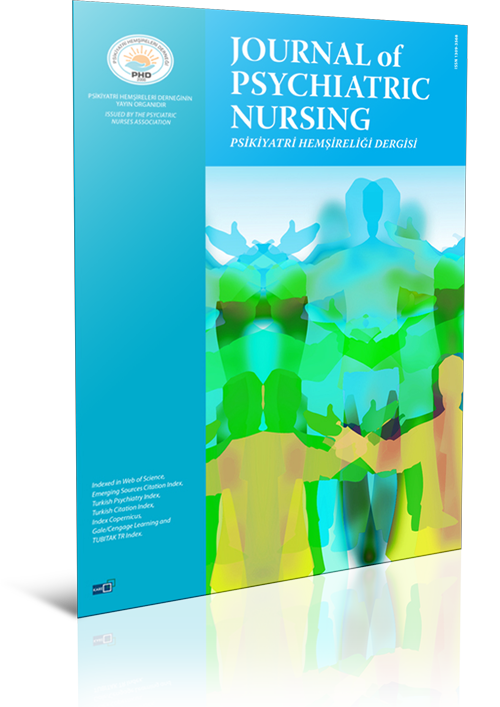
Volume: 9 Issue: 2 - 2018
| 1. | Frontmatter Pages I - III |
| EDITORIAL | |
| 2. | Editorial Nurhan Eren, Nazmiye Kocaman Yıldırım Page IV |
| RESEARCH ARTICLE | |
| 3. | Identifying the schizophrenia patients attending the rehabilitation program conducted in Community Mental Health Centers in terms of some demographic variables, characteristics related to the ailment, adaptation to the treatment and self-efficacies Gonca Üstün, Leyla Küçük, Sevim Buzlu doi: 10.14744/phd.2018.87699 Pages 69 - 79 INTRODUCTION: The aim of this study is to identify the schizophrenia patients attending the rehabilitation programs conducted in community mental health centers, in terms of demographic variables, characteristics related to the ailment, adaptation to the treatment and self-efficacies. METHODS: The present study, which was planned as a comparative-descriptive study, was conducted at the Community Mental Health Center in Amasya from January through March 2016. The group of this study was comprised of 64 patients, diagnosed with schizophrenia, half of whom would regularly participate in the rehabilitation program. The characteristics of both groups of schizophrenia patients were similar in terms of age, gender, age at the onset of the disease and duration of disease. Data obtained by personal information form, Morisky Adherence Scale, and Self-Efficacy Scale, was analyzed using the SPSS 20.0 software package. RESULTS: 71.9% of patients having attended the rehabilitation programs had been participating in the programs for longer than 6 months. 50% of the patients who had attended the programs and 25% of the patients who had not attended any program were consistent with the treatment. Although there were no significant differences between groups in terms of the level of medication adherence, schizophrenia patients participating in the rehabilitation program displayed higher levels of medication adherence. Female and single patients were more adaptable than male and married patients to treatment, respectively. The scale of self-efficacy mean score was found as 61.28±12.09 for the group having attended the programs, and 62.82±11.16 for those not having attended. There was no significant difference in self-efficacy scores between the two groups. DISCUSSION AND CONCLUSION: In this study, schizophrenia patients having attended rehabilitation programs display a higher adaptation to treatment than those not having attended. In this regard, it was recommended that patients should be encouraged to participate to rehabilitation programs. |
| 4. | Schizophrenia patients family environment, internalized stigma and quality of life Ebru Karaağaç Özçelik, Arzu Yıldırım doi: 10.14744/phd.2017.07088 Pages 80 - 87 INTRODUCTION: This descriptive study was performed to determine the family environment, internalized stigma and the quality of life of schizophrenia patients. METHODS: This study was performed between December 2011 and February 2012 with 51 outpatients and 51 patient relatives who were diagnosed with schizophrenia under DSM-IV-TR (American Psychiatric Association, 2000) and who were being monitored in clinical remission at the outpatient psychiatry clinic of Erzincan State Hospital. The study data were collected using a descriptive questionnaire, the Family Environment Scale (FES), the Internalized Stigma of Mental Illness Scale and the Abbreviated Turkish Version of the World Health Organization Quality of Life Questionnaire. RESULTS: This study found no significant difference between the mean scores of the patients and their relatives interpersonal relationships (43.94±8.20, 27.10±5.59) and control (46.29±6.72, 26.57±4.30) in the family environment (p>0.05). The patients mean score on the Internalized Stigma of Mental Illness Scale was 76.12±17.15. On its subscales, they were: alienation (15.63±4.41), stereotype endorsement (18.24±4.20), perceived discrimination (13.67±4.09), stigma resistance (12.35±3.6) and social withdrawal (16.24±5.21). and the patients perceptions of quality of life were: physical (12.00±2.75), mental (11.11±3.02), social (9.15±3.72), and environmental (11.56±2.61). DISCUSSION AND CONCLUSION: This study found no difference between the patients and their relatives perceptions of interpersonal relationships and control. The patients perceived internalized stigma above the moderate level. Their quality of life evaluations were at a moderate level. As their perceived internalized stigma level went up, their quality of life areas significantly decreased, and their perception of interpersonal relationships and control in the family environment increased significantly in the positive direction. It is important that psychiatric nurses assess the factors that affect patients relapses and treatment such as family environment and internalized stigma. They should also develop and implement programs. |
| 5. | Evaluation of the relationshipbetween the levels and perceptions of dyspnea and the levels of anxiety and depression in chronic obstructive pulmonary disease (COPD) patients Özge Kapısız, Fatma Eker doi: 10.14744/phd.2018.53244 Pages 88 - 95 INTRODUCTION: This study was performed with a descriptive design to determine the relationship between level and perception of dyspnea and levels of anxiety and depression. METHODS: The research data were collectedusing the Medical Research Council Scale and HAD via face- to-face interviews. RESULTS: The study consisted of a total of 90 individuals,which included 8 women and 82 men, with chronic obstructive pulmonary disease. It was determined that the average anxiety score was 7.42±4.43 (min: 0max: 20) and that the average depression score was 8.85±4.23 (min: 3-max: 18). According to the logistic regression analysis results,among the participants, those who indicated they had severe dyspnea or a background of psychiatric illness or showed depression symptomshad a 22.75 times, 4.304 times and 17.528 times higher risk, respectively, for anxiety symptoms. There was a greater risk of depression (5.957 times) in the participants who were suffering from severe dyspnea than in the patients with mild dyspnea, and a 22.181 times greater risk of depression in the participants who had been admitted to a hospital three or more times and a 12.352 times greater risk in patients who had been admitted one or two times a year than in the participants who had never been admitted to a hospital. Finally, there was a 28.712 times greater risk of depression in patients who did not have social support versus those that had, andthere was a 23.294 times greater risk of depressive symptoms in patients who presented symptoms of anxiety than in patients who did not. DISCUSSION AND CONCLUSION: Individuals with a high perception of dyspnea had a high risk of both depression and anxiety. |
| 6. | Evaluation of knowledge level about suicide and stigmatizing attitudes in university students toward people who commit suicide Ayfer Öztürk, Semiha Akın doi: 10.14744/phd.2018.49389 Pages 96 - 104 INTRODUCTION: This study was planned as a descriptive research with the aim to analyze university students level of knowledge and stigmatizing attitudes toward people who have committed suicide. METHODS: Research was conducted among university students (n=1100). Students stigmatizing attitudes toward suicides and level of knowledge about suicide were assessed using the Stigma of Suicide Scale (SOSS) and Literacy of Suicide Scale (LOSS). The Student Information Form was used to collect information about students age, gender, and marital status, a history of previous psychiatric support or psychological consultation services, and suicidal ideation or suicide attempts. RESULTS: Students who had previously had a psychiatric consultation or received a psychiatric diagnosis obtained a higher average of statistically significant LOSS scores compared to students who had not received psychiatric support (p=0.001). Students who had had suicidal ideation or suicide attempts in the past had a higher average of statistically significant LOSS scores compared to students who had not thought about or attempted suicide (p=0.001). Students who reported a history of suicidal ideation or suicide attempts had higher statistically significant average scores on the Glorification/Normalization subscale compared to students who had not reported a history of thoughts about or attempted suicide (p=0.001), and their Stigma subscale score average was lower (p=0.001). Students LOSS scores had a negative statistically significant relationship with SOSS Stigma subscale averages (r=-0.101; p=0.001). DISCUSSION AND CONCLUSION: Prevention of suicide attempts is an important public health problem; psychoeducational activities for university students need to be developed that include messages aimed both at increasing knowledge of suicide and reducing students stigmatizing attitudes toward suicide. Developing trainings for increasing awareness about the warning signs of suicide by community mental health nurses, specialist psychiatric nurses, or school psychologists is effective for suicide prevention. |
| 7. | The relationship between exam anxiety levels and sleep quality of senior high school students Selmin Köse, Şükran Kurucu Yılmaz, Sonay Göktaş doi: 10.14744/phd.2018.05025 Pages 105 - 111 INTRODUCTION: This study used a descriptive, cross-sectional and correlational research design to determine the relationship between exam anxiety levels and sleep quality of senior high school students. METHODS: Research data were collected in a high school in Istanbul, Turkey between January 131, 2017. 104 high school students volunteered to participate in the research for a sample size (n=104). The rate of return is 86.6%. Data were collected using the Information Form, the Exam Anxiety Inventory and the Pittsburgh Sleep Quality Index. SPSS statistical software program was used to evaluate the data. RESULTS: 55.8% of the students were female and their mean age was 17.27 years. 77.9% of the students stated that the university entrance exam was very important, and 74.8% stated that they did not have a sleep problem before they started to prepare for the university entrance exam. There was a weak positive relationship between the subjective sleep quality of students and the Delusion sub-dimension of the Exam Anxiety Inventory (r=0.258; p<0.01), a weak positive relationship between Affectivity sub-dimension (r=0.259; p<0.01) and a weak positive relationship between the total score of exam anxiety (r=0.272; p<0.01). There was a weak positive relationship between sleep disorder and the Delusion sub-dimension (r=0.210; p<0.05), a weak positive relationship between Affectivity sub-dimension (r=0.291; p<0.01) and a weak positive relationship between the total score of exam anxiety (r=0.273; p<0.01). The levels of both the Delusional dimension (p>0.05) and the Affectivity dimension (p>0.05) of the students did not affect subjective sleep quality. While the students' Delusion level did not affect the level of sleep disorder (p=0.701 >0.05), their Affectivity level increased the level of sleep disorder (ß=0.028). DISCUSSION AND CONCLUSION: Research data illustrated that senior high school students had exam anxieties which negatively affected their sleep quality. |
| 8. | Examination of humor styles and mental health status of health services students in vocational schools Şeyda Ökdem, Ebru Akgün Çıtak, Sevcan Avcı Işık, Nalan Özhan Elbaş doi: 10.14744/phd.2017.29981 Pages 112 - 118 INTRODUCTION: The aim of the study is to determine the humor styles and general mental health of health services students in a vocational school in Turkey. METHODS: This descriptive study was conducted in Turkey in 2013. A total of 354 of health services students from vocational schools agreed to participate in the study. Data were collected from students using a descriptive form, a humor styles questionnaire and a General Health Questionnaire (GHQ 12). Data were analyzed using SPSS 17.0. Descriptive and Pearson tests were used to analyze the study data. RESULTS: Students mean ages was 21.01±2.26, most participants were women (64.5%), of a moderate socio-economic status (61.9%) and non-smokers (63.8%). The students mean scores for the humor sub-scales are as follows: Affiliative humor 39.63±8.18, self-enhancing humor 33.64±9,44, aggressive humor 23.29±7.67 and self-defecting humor 26.51±7.87. Most of the students GHQ scores suggested that participants were at risk of having a mental health disorder (20.6%), while 27.1%were found to be at high risk of having a mental health disorder. A low negative significant correlation between the students self-enhancing humor and general health risk was found. DISCUSSION AND CONCLUSION: The study found that students have positive humor styles. Nearly half of the student partisans were found to be at a low risk regarding the development of psychiatric disorders. |
| 9. | Personality characteristics of nurse managers: The personal and professional factors that affect their performance Handan Alan, Ulku Baykal doi: 10.14744/phd.2017.08870 Pages 119 - 128 INTRODUCTION: Managers personalities indicate how they think, perceive reality, and relate to others; these qualities affect their decision making and problem-solving methods. Although there are many studies of leadership and managerial characteristics in the nursing profession, there is a lack of adequate data about personality characteristics. This descriptive study aims to determine the personal characteristics of nurse managers and the personal and professional factors that affect them. METHODS: The study population consisted of nurses working in administrative positions at hospitals affiliated with the public hospitals union, in research, and in practice hospitals affiliated with universities and private hospitals in cities in the Marmara Region. The final study sample consisted of nurse managers working in the hospitals that gave permission to conduct the study (excluding the private branch hospitals). The data were collected after obtaining the approval of the Clinical Research Ethics Committee of Çanakkale Onsekiz Mart University (Approval date: 1.7.2015, Decision No: 2015-01) and written official permission from the administrations of the hospitals included in the study. The data were collected using the Five Factor Personality Inventory. The data analysis was carried out using means and standard deviations (SD) as descriptive statistics, one-way analysis of variance for inter-group comparisons, and the independent samples t-test for paired group comparisons. A significance threshold of p<0.05 was used to evaluate the findings. RESULTS: The study included 900 nurse managers; they obtained the highest mean score on the conscientiousness dimension (Mean±SD=4.22±0.35). This dimension was followed by their mean scores on the agreeableness (Mean±SD=4.06±0.40), intelligence (Mean±SD=4.05±0.37), extroversion (Mean±SD=3.50±0.43), and emotional instability (Mean±SD=2.07±0.53) dimensions. Statistically significant differences were found between the independent variables of age, gender, marital status, education level, work institution, professional experience, institutional experience, managerial experience, administrative position, work unit, and managerial education when compared using the five-factor personality inventory (p<0.05). DISCUSSION AND CONCLUSION: The nurse managers described themselves as being highly conscientious. Statistically significant differences were found between the five-factor personality inventory mean scores and personal and professional characteristics. |
| REVIEW | |
| 10. | Compassion fatigue: The known and unknown Tuğba Pehlivan, Perihan Güner doi: 10.14744/phd.2017.25582 Pages 129 - 134 Compassion, known as a fundamental feature of the nursing profession, and considered a motivation to act to alleviate the suffering of others. Compassion fatigue is expressed as an adverse effect of helping individuals suffering from traumatic events or otherwise. However, compassion fatigue is defined differently in in recent nursing studies, and the developmental process of compassion fatigue has been explained with the help of different models. Since compassion fatigue, a subject of interest for nurse researchers, lacks a clear understanding, it leads to a conceptual complexity in previous studies. In this review, compassion, compassion fatigue, concepts related to compassion fatigue, and the development of compassion fatigue are discussed in the light of previous studies. |
| 11. | Emotional eating, the factors that affect food intake, and basic approaches to nursing care of patients with eating disorders Yeliz Serin, Nevin Şanlıer doi: 10.14744/phd.2018.23600 Pages 135 - 146 Emotional eating is defined as an eating behavior that is hypothesized to occur as a response to emotions, not because of a feeling of hunger, closeness to meal time, or social necessity. Eating behavior can be regulated using metabolic methods that cause homeostasis, neuropsychological agents such as hormones and neurotransmitters, and hedonic systems. There is an opinion among scholars that the people who have an addiction and/or tendency to overeat specific nutrients or substances may have a shortage of dopamine (DA). Emotional and uncontrolled eating behavior is an important risk factor for recurrent weight gain. Although, emotions are known to be an influential factor on eating functions, food selection, and amount of food consumption, a clear relationship about what affects eating behavior has to date not been proven. Therefore, in this study, emotional factors that affect emotional eating and food intake, other factors affecting nutrient intake (i.e., diseases, natural disasters, menstruation), various theories related to emotional eating, the scales which developed to detect emotional eating behavior, and the basic responsibilities of nurses in the treatment of eating disorders are discussed. |


















